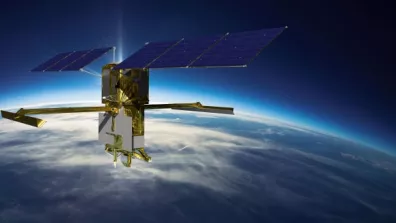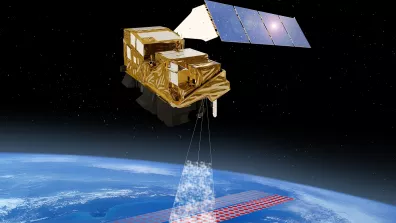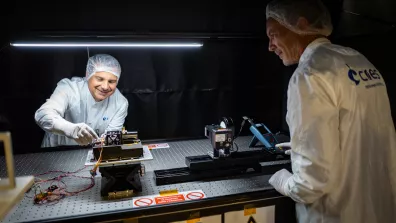Between 10 and 20 July, the French-American SWOT satellite, which measures the height of water bodies and the ocean around the globe, climbed to its final orbit. CNES teams performed a series of manoeuvres to raise the satellite's altitude by 33 kilometres. Christophe Maréchal, SWOT Operations Project Manager, and Saïd Haouchine, Mission Manager at the SWOT Control Centre, fill us in on the details.
Why the change of orbit?
The satellite has been in a calibration and validation orbit for 6 months, and the aim of the orbit change — also known as repositioning — is to transfer it to its final orbit at an altitude of 891 kilometres. To achieve this, the satellite carried out 4 manoeuvres, each comprising 2 thrusts.
"A thrust consists of firing the satellite’s thrusters to tilt it and move it to a particular point in orbit, explains Saïd Haouchine."
The manoeuvres worked like a charm and enabled the satellite to climb 33 kilometres up to its scientific observation orbit.
Manoeuvres spread over several days
The various operations, which involved several ancillary activities, were spread over 2 weeks. This allowed the various CNES teams to coordinate their respective manoeuvres, which must take place with at least 48 hours in between.
Christophe Maréchal, SWOT satellite operations project manager at CNES, explains the need for a 48-hour interval between two manoeuvres.
This time is needed for programming the commands, simulating trajectories and checking that there is no risk of collision with other satellites or debris. It also means that the orbital elements in the satellite telemetry can be retrieved to calculate its new orbit and check that it is as expected.
- Mission Manager at the CNES SWOT spacecraft control centre
He adds: “The large distance involved in this change of orbit, the satellite's own propulsion capability and uncertainties about the risks of collision mean that the spacecraft cannot be repositioned in a single manoeuvre.”
In addition to the operational constraints, the measuring instruments must be secured before and after each manoeuvre.
The role of CNES and its teams
Drawing on its expertise in satellite positioning and station-keeping operations, CNES carries out all orbit change manoeuvres from the Toulouse Space Centre.
CNES's SWOT teams were mobilised, whether at the mission centre, which is responsible for data production, verification and distribution, or at the spacecraft control centre, which is in charge of satellite programming and security.
One of the many roles of the spacecraft control centre is to ensure that all the teams have the necessary information. This organisation allows the mission centre, for example, to stop data processing at the beginning of the orbit change in order to reconfigure its tools and be ready to process the telemetry received from the satellite once in its new orbit.
More generally, these activities involved 20 people over 2 weeks in calculating manoeuvres, checking that there is no risk of collision and that the uploaded satellite commands are working correctly, as well as managing the availability of the spacecraft control centre for coordinating the ground stations. Christophe Maréchal adds:
"Some instruments, such as the KaRIn radar interferometer, are handled by NASA’s Jet Propulsion Laboratory, so CNES and its American partner had to coordinate closely”.
The practical reason for the change in orbit
As well as marking the end of the calibration and validation phase, this change of orbit signals the start of the SWOT satellite’s nominal phase, known as its 'science' or 'routine' phase.
Christophe Maréchal explains, “During the calibration and validation phase, the satellite was positioned in an orbit that had the advantage of repeating the same measurements over the same geographical areas of the Earth once every 24 hours. However, under these conditions, measurements were only taken for a very small portion of the globe. This nevertheless enabled local measuring instruments to be positioned in the areas measured and multiple checks to be made”.
He adds: “This phase enabled us to calibrate the instruments, but also to start refining the processing algorithms, and overall to prove the reliability of the SWOT system as a whole”.
The new orbit at an altitude of 891 kilometres means that the satellite can now provide measurements of the whole planet every 21 days. Thanks to the overlapping of ground tracks, some points on the globe will even be observed more regularly.





